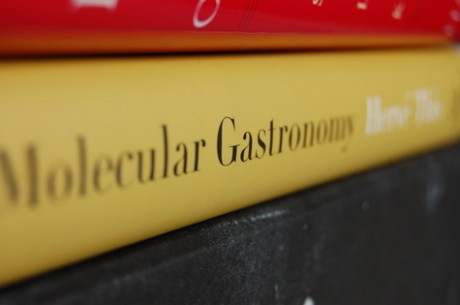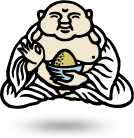Translate This: Hervé This Part II
Posted by Pailin Chongchitnant on Tuesday, June 21st, 2011
Here goes part two, the sauce accompanying the poached pear. Prepare yourself for an intense chemistry lab report!
And now, the crème anglaise. We make the crème anglaise by putting egg yolks and sugar in a pot and beating them together until it makes “a ribbon.” It is said that if you let the yolks and the sugar sit for too long before beating, the yolks will “burn.” A professional pastry book explains that,
“All fat cells are attracted by sugar. The yolk contains phospholipid cells, and upon contact with sugar, a heat-releasing chemical reaction occurs at the contact surface between the sugar and the yolk. This released heat is enough to coagulate the surface of the yolk if you don’t stir it promptly.”
I don’t know where in their research the authors of this book found this baloney, because there isn’t any sense in it. The authors are confusing “cells” (the little living bags that make up animals, plants, and microorganisms) and “molecules” (the assembly of atoms which make up all things, and, notably, cells.) In fact, egg yolks don’t contain “phospholipid cells” but phospholipid molecules, which are just complicated words to describe the molecules making up egg yolks. And finally, the contact does not lead to a heat-releasing reaction.
However, we all know that sugar attracts water, and so it draws water out of the neighboring yolk. Protein molecules (the other type of molecules in yolks) form a crust around the sugar granules (we can see this under a microscope), which prevents the sugar crystals from dissolving. And that is why burnt yolks are grainy. So then, when we beat the yolks until it forms a ribbon, the mixture of the unburnt yolks and sugar is enriched with millions of air bubbles (we can also see this under a microscope), which gives smoothness and the whitened color (the yolks whitens for the same reason that egg whites whiten when beaten into a meringue.) In burnt yolks, the molecules can no longer be surrounded by air bubbles, and the mixture cannot have the consistency of a mousse.
After having made the ribbons, we add some milk which we have infused with flavoring such as vanilla. We cook the mixture on low heat until the crème coats the spatula, and we try to avoid lumps. If it becomes lumpy, some say that you can recover it by shaking it in a bottle with some milk. Is it exactly like that?
First of all, the question is, what are these lumps? Simply explained, they are macroscopic aggregates of protein. To really understand these lumps, we must compare a successful crème anglaise to a lumpy one. During this comparison, we discovered that successful crème anglaise, although successful, contained protein aggregates, without which one cannot explain the change in texture obtained by heating.
The experiment was done by putting 100 mL milk, 50 g sugar, and 1 yolk in a beaker, and then heating it in a microwave (900 W). The heating was done in 10-second bouts, on medium power, until there was a change in texture that we looked for in a crème anglaise. This cream was observed under a microscope, which revealed the protein aggregates we were expecting. Then, we kept heating the custard until lumps were just starting to form, and then we also observed it under the microscope. The structure of the protein aggregates were analogous to the previous, but the size was about double. We then made a “failed” crème anglaise intentionally by prolonging the heating in the microwave. The microscope showed the same protein aggregates as were found in the slightly lumpy one, but they were more closely clumped together in groups.
Conclusion: a successful crème anglaise differs microscopically from a failed one only by the size of the protein aggregates. Like many things in cooking, an even dispersion of something gives a more pleasant sensation. Could we then fix a failed a crème anglaise by shaking it vigorously in a bottle? The crème anglaise we experimented on previously were fixed by putting it through a mixer, whose function was to dissociate these aggregates from each other. Not only is the homogeneous distribution of these protein aggregates were obtained, but the size of the aggregates were also close to that of a successful crème anglaise. Conclusion: unless the chemical state is changed, in which case a trained palate could detect a difference between a successful and a failed crème anglaise, it can be rescued by mechanical agitation. Note that the mixer inconveniently introduces air bubbles into the crème anglaise. To detemine if the taste changes when we recover a crème anglaise, we must compare a crème anglaise made successfully with a mixer and a failed one that was recovered by a mixer.
In Practice
In a pot with a lid, reduce a good red wine that is light and fragrant (from Savoie), add cinnamon sticks, lemon juice, a vanilla bean, and some sugar.
When the pear is cooked* set it aside and make two reductions of the same wine: in the first pot, we will add a half sheet of gelatin, and in the second one, we will add a teaspoon of starch, a teaspoon of sugar, and a teaspoon of sugar. When the wine is reduced by three quarters, add fresh wine to bring it back to its original volume, and reduce again. We will obtain finally a syrupy consistency but not thick. These two sauces are served hot.
*It does not say when to cook the pear, but I assume the pear was to be cooked in the “light and fragrant wine of Savoie.”

